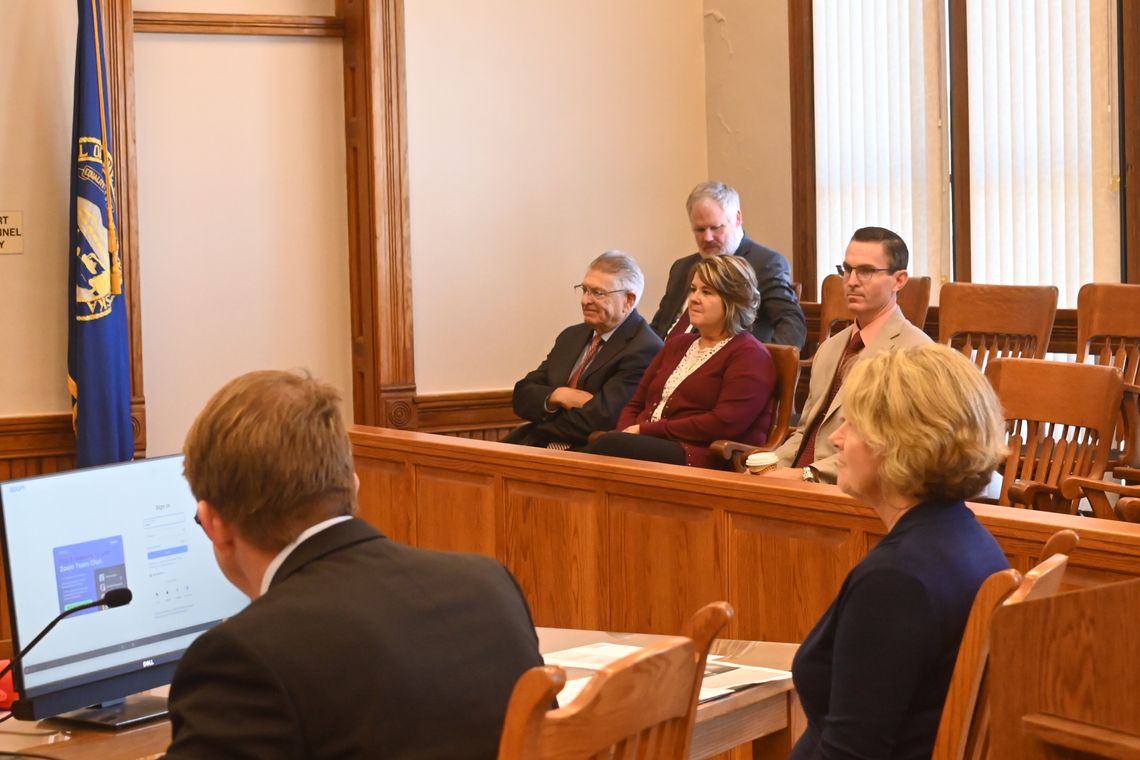HARTINGTON — Chief Justice Michael Heavican saw firsthand how new courtroom technology works (and sometimes doesn’t work) during a visit to Cedar County on Aug. 15.
The chief justice of the Nebraska Supreme Court and four other higher court justices, along with state and local court staff, were in the Cedar County District Court’s courtroom to get a firsthand glimpse at their investment into audio-visual technology for courtrooms across the state.
Cedar County was the first county in Nebraska to have the new technology installed that allows for remote video conferencing, digital displays of exhibits and more.
As part of the demonstration, the group was treated to a mock protection order hearing, which included documents, photos and video shown on a large courtroom screen, as well as remote conferencing by both a court reporter and a witness. The mock hearing, including the plaintiff, defendant, the attorneys and judges, appeared in person.
If there was one thing received into evidence during the demonstration, it’s that the Cedar County court staff work well under pressure. That’s because things did not go according to script with one of the remote “witnesses” trying to join the hearing from Madison. It took about 15 minutes for both the video and audio to fully connect to the Cedar County courtroom.
During this time, District Court Clerk Janet Wiechelman and County Court Clerk Diane Sudbeck were assisted by Chad Cornelius, chief information officer at the Nebraska State Court Administrator’s Office, who was on hand for the event.
Trying to keep the mood light, District Court Judge Bryan Meismer said, “For what it’s worth, this was working just fine the other day.”
He said the technology has been a valuable resource in the courtroom, but there’s bound to be kinks in the system from time to time.
“All you can do is try to keep it light. It’s in your head. You’re frustrated. You’re just trying to keep your cool and trying to roll with it,” he said. “In that situation, you give respect to the people who are there with real problems, but you’re also trying to dial back the tension a little bit. . . . There’s always that moment of we’re trying to get the technology to work or get the witness online. . . . You’re mostly just trying to keep it professional, keep it moving, and we are just trying to figure it out.”
The new technology has been implemented in about half of the state’s courtrooms and Heavican said it was important for him to see it in action. He touted the benefits in efficiency, saving both time and money for counties, lawyers and their clients.
Justice William Cassel said the new technology upgrades also allow for a standard across the state.
“Our effort is to make sure every courtroom in the state gets up to the current standards, the best we can do,” he said. “We’re doing it because we believe it’s essential to the uniform administration of justice across the entire state and brings fairness and equity to all the citizens, whether they are from Hartington … O’Neill, Omaha or Lincoln.”
Cassel said face-to-face interactions between the public and a judge or other court staff remain vital.
“Efficiency is a balance you have to do,” he said. “I used to do a lot of traveling up and down the highway and I would end up in counties for a hearing where no one else wanted to be there. They wanted to show up by telephone. When we provide the audio-video experience, it’s not the be-all, end-all, but it’s a great tool.”
Cedar County was chosen as the first county for the technology upgrades due to its court leaders — Sudbeck and Wiechelman — being proactive, Cassel said.
Cedar County provided an ideal place to start the rollout of statewide technology because of its location and size as well, Heavican said.
The Cedar County District Court first used the new audio-visual equipment in October 2022. The new equipment and installation valued at $90,000 for both courts - was paid by the Nebraska Court Administrator’s Office and comes with a five-year warranty and service plan. The perpetual upkeep of the equipment will be at the county’s expense.
Cedar County commissioners and State Sen. Barry DeKay were also in attendance at last week’s Nebraska Supreme Court summer tour visit.
As part of the Chief Justice’s summer tour, he also visited the Saunders, Colfax, Dakota, and Platte County courthouses; the Madison Detention Center; the District 6 Reporting Center in South Sioux City; Winnebago Tribal Court; Fremont Mediation Court; and the new Douglas County juvenile court.
Summer visits are not only an opportunity to express the Court’s appreciation to community leaders for their support but also to gain valuable insights into the implementation of policies throughout the state.
The Supreme Court and Chief Justice pay particular attention to the effectiveness of various court processes and use the visits to identify areas where assistance is requested, especially in technology and services.
Shortly after Heavican was named Chief Justice in 2006, he established the goal of visiting every one of the 93 courthouses and communities in Nebraska. Having accomplished that goal, he continues to visit courthouses across the state, often accompanied by his fellow justices. Additionally, he established a program of traveling Supreme Court argument sessions in Nebraska high schools while maintaining annual visiting argument sessions in each of Nebraska’s Law Schools.
.jpg)











